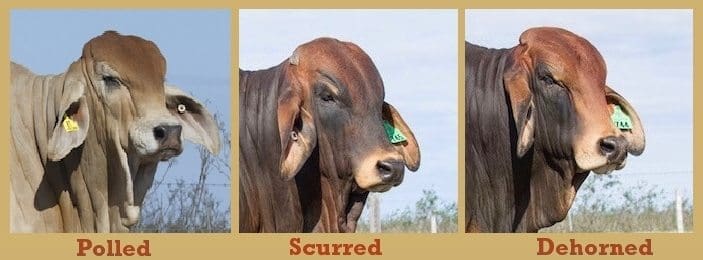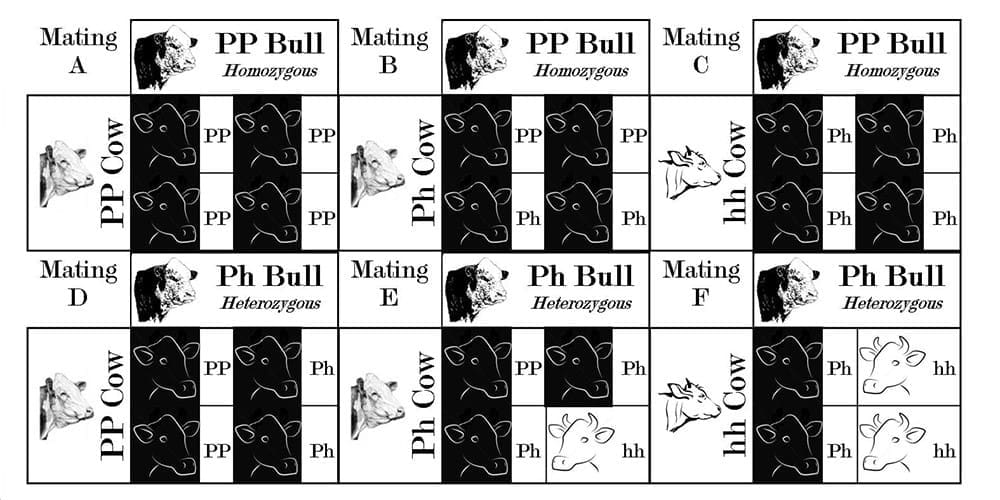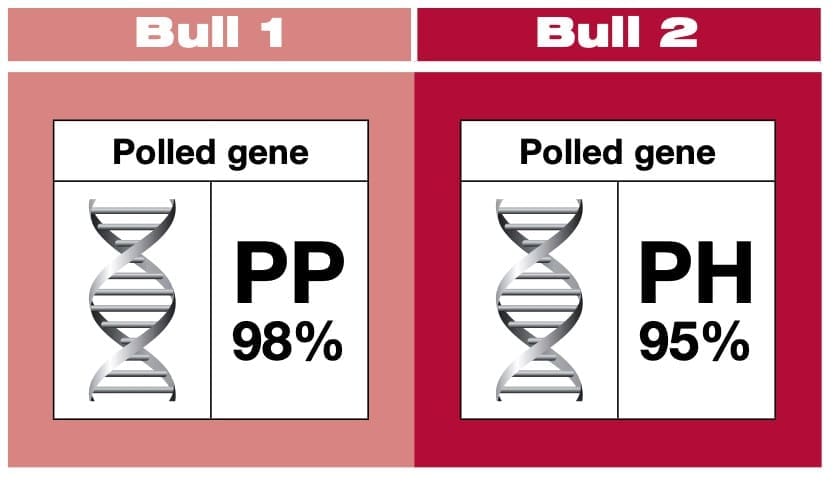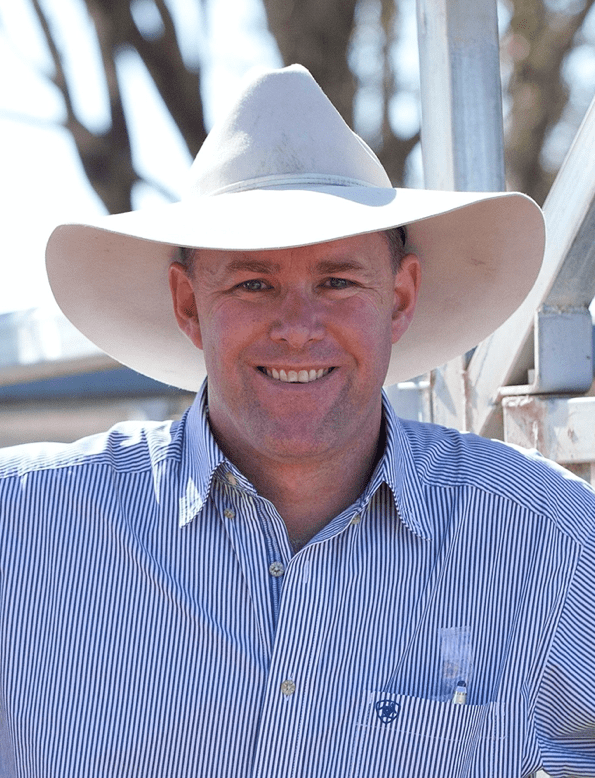
OVER the past 24 years, momentum has increased across many of the major breeds in Australia to breed for polledness.
There are several contributing reasons for this momentum. The most commonly cited are associated with carcase damage through bruising followed by the benefits to workplace safety for staff, and improved animal welfare.
Beef Central looked at the changing status of horns in purebred herds in this article in 2020, and the trend across the major breeds was reported from an MLA – QAAFI report was an increase in the number of polled and scurred cattle. Strong uptake of Wagyu genetics (100pc horned cattle) in some herds recently may have moved against that trend a little, however.
On a broader level, dehorning and disbudding is seen a significant issue for the cattle industry. Increasing scrutiny of welfare practices, along with the associated losses incurred among animal’s post dehorning is potentially a greater driver of momentum towards polled animals.
Research undertaken by the CRC for Beef Cattle in northern Australia determined that almost all post-weaning deaths in calves was attributable to dehorning. Sixteen percent of all calf losses recorded were attributable to dehorning.
Changing the horn status of a herd genetically is a longer-term solution to this issue.
While genetics does have the potential to effectively help producers achieve a polled herd, it is a process that can take multiple generations. While many producers are prepared to undertake the process, they often overlook the basis of genetics and can become very disappointed when their new polled bull sires calves that are scurred or possibly horned.
In those breeds where it is present, polledness is a trait that is controlled entirely by genetics, which does allow changes across a herd to be made without influence from the production environment. As a trait, polledness is controlled by only a few genes, and there are two basic alleles, or forms of the gene that every animal possess. An animal inherits one form of the gene from its sire, and the other from its dam.
Many producers are conscious of the fact that the allele for polledness is dominant over the allele for horns. This awareness is the cause for many producers to expect that using a polled bull is enough to ensure their next generation of calves will be entirely polled. That expectation can often lead to disappointment.
The reason for this comes back to the combination of alleles that the calf has inherited from its sire and dam.
It simply isn’t enough for producers to visually look at a sire or a dam and in the absence of visible horns assume that they are using the right combination of polled genes.
Animals can be Homozygous Polled, which describes an animal that has inherited two alleles for polledness (PP). However it is possible that a polled animal may have only one allele for polledness. The other is an allele for horns. Known as a Heterozygous animal (PH) the animal could be visually have no horns or perhaps may exhibit scurs.
An animal with two* alleles for horns is Homozygous Horned (HH). (*editor’s note: The original version of this article carried a mistake – it said no alleles, not two alleles).
From a visual perspective, the absence of horns does not prove an animal will breed progeny that are in turn polled. A polled animal may only have one allele for polledness (heterozygous). Being a dominate gene, this has prevented that animal from exhibiting horns or scurs. However, when joined with a Heterozygous animal, there is a 25pc chance the calf will be born with horns.
There are a number of potential outcomes that can occur for producers attempting to breed for polledness. These are best outlined in the illustration below:

Where producers have the opportunity to use a Homozygous Polled sire (PP) they have the greatest opportunity to produce a generation that visually will be polled or scurred.
The scurs gene is a separate gene that interacts with the Polled gene and is only expressed in the presence of the poll allele. In practice this means scurred animals will only be found with the genotypes PP or PH. As a physical expression, scurs are also sex dependent. Male animals can exhibit scurs with only one copy of the Scur gene, while females require two copies.
In practical terms this can explain why producers in their first use of a polled bull may observe more scurred male calves.
It is often in the second generation of calves that many producers can become disheartened in breeding for polledness. Many herds that appear polled are actually comprised of females that are Heterozygous (PH). Visually these females are polled. When joined to a Homozygous bull (PP) there is no issue regarding the appearance of horns.
However, if a producer used a Heterozygous bull of those cows, at least one in four calves will be born with two alleles for horns and will have visual horns develop. The other three calves will be polled or scurred.
With this in mind there is a pretty clear message for producers who are seeking to embark on the process of breeding for polledness. That is, success is more likely to be achieved if the genetics of the animals are known. At the very least, being certain that any sires being used are Homozygous Polled (PP).
It is possible to make accurate and informed decisions regarding a sire’s genetics for polledness. The Australian Poll Gene Marker Test can be used in temperate and tropical breeds with an extremely high level of accuracy.

Determining if a sire is a Homozygous Poll or a Heterozygous Poll can determine potential joining groups. Not every producer will test their cow herd for the presence of the polled genes. In many commercial herds it is likely a herd will be a mix of Heterozygous cows (PH) and Homozygous Horned Cows (HH).
On this basis using a Homozygous Polled bull (PP) in herds (as demonstrated in Figure 1) the outcome will be polled calves. However, to successfully transition a herd toward Homozygous polledness requires the use of Homozygous (PP sires) for several generations. Introducing a bull that appears polled but is actually a Heterozygous (PH) animal increases the opportunity for the expression of horns to occur and will delay the progression of the herd for several years.
As producers consider their breeding objectives in the choice of sires this year, considering the genetic status of a sire should be a significant focus.
Choosing a tested sire will offer greater opportunities for improvement and for a quicker transition away from issues associated with horns in the herd.
 Alastair Rayner is the Principal of RaynerAg, an agricultural advisory service based in NSW. RaynerAg is affiliated with BJA Stock & Station Agents. He regularly lists and sell cattle for clients as well attending bull sales to support client purchases. Alastair provides pre-sale selections and classifications for seedstock producers in NSW, Qld and Victoria. He can be contacted here or through his website www.raynerag.com.au
Alastair Rayner is the Principal of RaynerAg, an agricultural advisory service based in NSW. RaynerAg is affiliated with BJA Stock & Station Agents. He regularly lists and sell cattle for clients as well attending bull sales to support client purchases. Alastair provides pre-sale selections and classifications for seedstock producers in NSW, Qld and Victoria. He can be contacted here or through his website www.raynerag.com.au

Alastair is wrong about scurs. PP animals (male or female) will never be scurred.
Alistair,
A great article! I teach Genetics to my Year 10 Animal Husbandry students, at Tully State High School. We also run a financially self-sufficient Droughtmaster Stud, to industry standard and test for the Homozygous PP genes, so this is very relevant to us.
My students can understand you article, so I will make up a question from it. Thank you.
Regards,
Warren Giffin
Agriculture Co-ordinator
Tully State High School
Mob: 0427790085
E-mail: wgiff2@eq.edu.au
After 16 years of careful and planned introgression of the Celtic Poll Gene (Pc) into our Tropical Composite Nucleus population, first using the CSIRO Australian Poll Test, then the first to use the German Genomic markers, we are now 94% PcPc and will soon be 100%.. Greg Popplewell, Popplewell Composites
The key to accurate and constant change for this trait is the availability of information on tested animals. With numerous genomic service providers and breed societies offering accurate tests for poll/horn status and the relatively low costs of genomic testing (less than 2%) of bull sale value it is bewildering why bull (and Merino ram) breeders who are promoting poll genetics don’t test all available sale animals. The market will then determine the value of a PP vs PH animal depending on a range of other traits and important structural determinations. But buying untested poll animals is like flipping a coin. Even the most astute breeders still get PH and PP wrong at times if not tested.
A few pastoral companies are reaping the benefits of applying Aluspray at dehorning – an aluminium spray on bandage that acts as a barrier to dust, infection, flies and micro-organisms.
Good article Alastair.
The key thing in a commercial herd is to not to overthink this and buy polled bulls whether they are homozygous or heterozygous and select as many phenotypically polled replacement heifers as possible.
In a perfect world everyone would buy homozygous bulls, but the extra cost is hard to justify so the logical solution is to buy a mix of homozygous and heterozygous bulls that meet the business’s other selection criteria.
In predominately horned herds buying polled bulls whether they are homozygous or heterozygous produces a dramatic reduction in the number of horned animals. At the end of the day this is the objective.